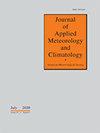Polarimetric Radar Observation of the Melting Layer in a Convective Rainfall System during the Rainy Season over the East China Sea
IF 2.6
3区 地球科学
Q3 METEOROLOGY & ATMOSPHERIC SCIENCES
引用次数: 20
Abstract
During the rainy season over the East China Sea, convective rainfalls often show melting layer (ML) characteristics in polarimetric radar variables. In this research, the appearance ratio of the ML (the ratio of rainfall area accompanied by polarimetric ML signatures) and the variation in height of the level of the ML signature maximum (MLSM level; defined by the level of the rhv minimum in the ML) in a convective rainfall region in a rainfall system over the East China Sea observed on 2 June 2006 were studied using C-band polarimetric radar (COBRA). For this analysis, a method of rainfall type classification that evaluates the presence of an ML in addition to providing conventional convective‐stratiform classification using range‐ height indicator (RHI) observation data was developed. This rainfall type classification includes two steps: conventional convective‐stratiform separation using the horizontal distribution of Zh at 2-km altitude, and ML detection using the vertical profile of rhv at each horizontal grid point. Using a combination of these two classifications, the following four rainfall types were identified: 1) convective rainfall with an ML, 2) convective rainfall with no ML, 3) stratiform rainfall with an ML, and 4) stratiform rainfall with no ML. An ML was detected in 53.9% of the convective region in the rainfall system. Using the same definition, an ML was detected in 83.1% of the stratiform region. The ML in the convective region showed a marked decrease in rhv coincident with an increase in ZDR around the ambient 08C level, as did that in the stratiform region. Melting aggregated snow was the likely cause of the ML signature in the convective region. The average height of the MLSM level in the convective region was 4.64 km, which is 0.46 km higher than that in the stratiform region (4.18 km) and 0.27 km higher than the ambient 08C level (4.37 km).东海一次雨季对流降水系统融化层的极化雷达观测
在东海雨季,对流降水在极化雷达变量中经常表现出融化层(ML)特征。在本研究中,ML的出现比(伴随极化ML特征的降雨面积比)与ML特征的高度变化最大的水平(MLSM水平;本文利用c波段偏振雷达(COBRA)研究了2006年6月2日观测到的东海一个降雨系统中对流雨区的低辐压水平。为了进行这项分析,除了使用距离-高度指示器(RHI)观测数据提供传统的对流-层状云分类外,还开发了一种降雨类型分类方法来评估ML的存在。这种降雨类型分类包括两个步骤:利用Zh在2公里高度的水平分布进行常规对流-层状分离,以及利用rhv在每个水平网格点的垂直剖面进行ML检测。结合这两种分类,确定了4种降雨类型:1)有ML的对流降雨,2)无ML的对流降雨,3)有ML的层状降雨,4)无ML的层状降雨。降雨系统中对流区域有53.9%检测到ML。使用相同的定义,在83.1%的层状区域检测到ML。对流区的ML与层状区一样,在08℃附近,rhv明显降低,ZDR明显增加。积雪融化可能是对流区ML特征的原因。对流区MLSM层位平均高度为4.64 km,比层状区(4.18 km)高0.46 km,比环境08℃层位(4.37 km)高0.27 km。
本文章由计算机程序翻译,如有差异,请以英文原文为准。
求助全文
约1分钟内获得全文
求助全文
来源期刊
CiteScore
5.10
自引率
6.70%
发文量
97
审稿时长
3 months
期刊介绍:
The Journal of Applied Meteorology and Climatology (JAMC) (ISSN: 1558-8424; eISSN: 1558-8432) publishes applied research on meteorology and climatology. Examples of meteorological research include topics such as weather modification, satellite meteorology, radar meteorology, boundary layer processes, physical meteorology, air pollution meteorology (including dispersion and chemical processes), agricultural and forest meteorology, mountain meteorology, and applied meteorological numerical models. Examples of climatological research include the use of climate information in impact assessments, dynamical and statistical downscaling, seasonal climate forecast applications and verification, climate risk and vulnerability, development of climate monitoring tools, and urban and local climates.

 求助内容:
求助内容: 应助结果提醒方式:
应助结果提醒方式:


